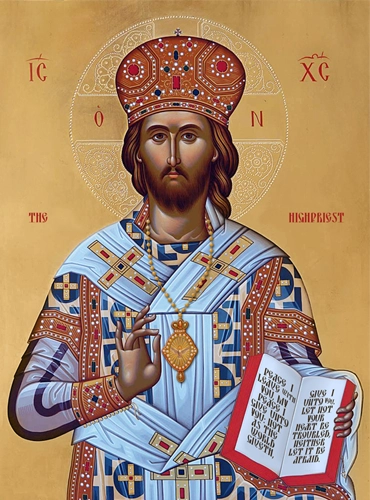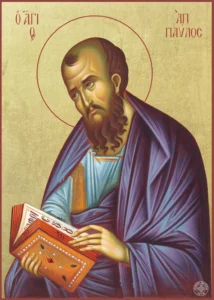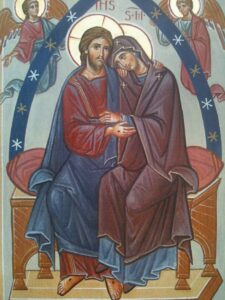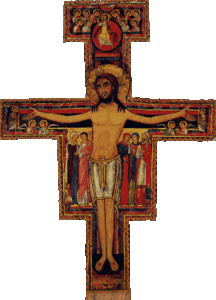*The Spanish word used is yerra, meaning the mark that is left after branding an animal; the Spanish footnote reads: Real Academia Española, Diccionario de la Real Academia Española (Madrid, 1992) 1502, vocablo «Yerra»: «R. de la Plata. Hierra, acción de marcar con hierro los ganados».
I
As we know, there are three sacraments that imprint character (in those three sacraments the character is the res et sacramentum). When speaking of the symbols of the Holy Spirit, the Catechism of the Catholic Church teaches that “the seal is a symbol close to that of anointing. The Father has set his seal (Jn 6:27) on Christ and also seals us in him. Because this seal indicates the indelible effect of the anointing with the Holy Spirit in the sacraments of Baptism, Confirmation, and Holy Orders, the image of the seal (sfragi,j) has been used in some theological traditions to express the indelible ‘character’ imprinted by these three unrepeatable sacraments.”[1] Elsewhere it adds: “The three sacraments of Baptism, Confirmation, and Holy Orders confer, in addition to grace, a sacramental character or ‘seal’ by which the Christian shares in Christ’s priesthood and is made a member of the Church accord-ing to different states and functions. This configuration to Christ and to the Church, brought about by the Spirit, is indelible; it remains forever in the Christian as a positive disposition for grace, a promise and guarantee of divine protection, and as a vocation to divine worship and to the service of the Church. Therefore these sacraments can never be repeated.”[2] The character is an inerasable and indelible seal of our belonging to and our configuration with Christ and His Church; accordingly, these sacraments are unrepeatable.
I will now examine the character that Holy Orders imprints on the soul.
II
Those who are called by God and the Church to Holy Orders receive an indelible spiritual mark. This mark is in addition to the two that they already possess: the character of Baptism, which consecrates us for participation in the holy liturgy and to exercise our baptismal priesthood by the witness of holy lives and practical charity,[3] and the character proper to Confirmation by which we “receive the power to profess faith in Christ publicly and as it were officially (quasi ex officio).”[4]
The Council of Trent teaches that “the sacrament of Orders imprints character, which cannot be erased nor taken away . . . and those who receive it cannot return or become members of the laity again.”[5] The Tridentine fathers formulated this proposition against the opinion of Luther, who denied the sacramental character of orders: he affirmed that the priest is no different from the non-ordained, and that the ordained minister can return to being a lay person. By their proposition, we can see that the Fathers of Trent clearly had the intent to formulate a doctrine of faith; therefore, their teaching is a dogma.
With respect to bishops, the Second Vatican Council taught: “The Sacred Council teaches that by Episcopal consecration the fullness of the sacrament of Orders is conferred, that fullness of power, namely, which both in the Church’s liturgical practice and in the language of the Fathers of the Church is called the ‘high priesthood,’ the ‘supreme power of the sacred ministry.’ But Episcopal consecration, together with the office of sanctifying, also confers the office of teaching and of governing. . . . For from the tradition, which is expressed especially in liturgical rites and in the practice of both the Church of the East and of the West, it is clear that, by means of the imposition of hands and the words of consecration, the grace of the Holy Spirit is so conferred, and the sacred character so impressed, that bishops in an eminent and visible way sustain the roles of Christ Himself as Teacher, Shepherd and High Priest, and that they act in His person.”[6]
With respect to priests, the Council taught: “The office of priests, since it is connected with the episcopal order, also, in its own degree, shares the authority by which Christ builds up, sanctifies and rules his Body. Wherefore the priesthood, while indeed it presupposes the sacraments of Christian initiation, is conferred by that special sacrament; through it priests, by the anointing of the Holy Spirit, are signed with a special character and are conformed to Christ the Priest in such a way that they can act in the person of Christ the Head.”[7]
III
As if it were too little, the Magisterium of the Church has continued expounding the doctrine regarding the priestly character that the sacrament of Orders confers.
The Synod of Bishops in 1971[8] explained the priestly character as a participation in the priesthood of Jesus Christ in such a way that the priest is defined by the character that permanently marks him. That character makes him capable to act in the name of Christ and makes the priest a participant in the power of Christ so as to work in His Name. “From Christ and for the Church”[9] is how the Synod understood the indelible nature of the priestly character.
The Declaration In Defense of the Catholic Doctrine on the Church Against Certain Errors of the Present Day,[10] released by the Congregation for the Doctrine of the Faith on June 24th, 1973, states: “The Church has ever more closely examined the nature of the ministerial priesthood. . . . By the assistance of the Holy Spirit, she recognized more clearly as time went on that God wished her to understand that this rite conferred upon priests not only an increase of grace for carrying out ecclesiastical duties in a holy way, but also a permanent designation by Christ, or character, by virtue of which they are equipped for their work and endowed with the necessary power that is derived from the supreme power of Christ.”[11]
The Directory on the Ministry and Life of Priests, released by the Congregation for the Clergy on January 31st, 1994, teaches: “In priestly Ordination, the priest has received the seal of the Holy Spirit which has marked him by the sacramental character in order to always be the minister of Christ and the Church. Assured of the promise that the Consoler will abide with him forever,[12] the priest knows that he will never lose the presence and the effective power of the Holy Spirit in order to exercise his ministry and live with charity his pastoral office as a total gift of self for the salvation of his own brothers. . . . Through the sacramental character and the identification of his intention with that of the Church, the priest is always in communion with the Holy Spirit in the celebration of the liturgy, especially in the Holy Eucharist and the other sacraments. In fact, in each sacrament, Christ acts through the Holy Spirit, invoked by the priest who celebrates in persona Christi, with his efficacious power on behalf of the Church.”[13]
The Catechism of the Catholic Church likewise teaches: “This sacrament configures the recipient to Christ by a special grace of the Holy Spirit, so that he may serve as Christ’s instrument for his Church. By ordination one is enabled to act as a representative of Christ, Head of the Church, in his triple office of priest, prophet, and king. As in the case of Baptism and Confirmation this share in Christ’s office is granted once for all. The sacrament of Holy Orders, like the other two [Baptism and Confirmation], confers an indelible spiritual character and cannot be repeated or conferred temporarily. It is true that someone validly ordained can, for grave reasons, be discharged from the obligations and functions linked to ordination, or can be forbidden to exercise them; but he cannot become a layman again in the strict sense, because the character imprinted by ordination is forever. The vocation and mission received on the day of his ordination mark him permanently. Since it is ultimately Christ who acts and effects salvation through the ordained minister, the unworthiness of the latter does not prevent Christ from acting. Saint Augustine states this forcefully: As for the proud minister, he is to be ranked with the devil. Christ’s gift is not thereby profaned: what flows through him keeps its purity, and what passes through him remains dear and reaches the fertile earth. . . . The spiritual power of the sacrament is indeed comparable to light: those to be enlightened receive it in its purity, and if it should pass through defiled beings, it is not itself defiled (In Evangelium Johannis 5, 15).”[14]
The Catechism reaches two very clear conclusions: first, the priesthood lasts forever and is not something temporary; secondly, the dispositions of the minister do not substantially affect the consequences of the sacraments that he administers.
How marvelous is the sacrament of Orders! No one and nothing can take away the character of baptism, Confirmation, or of Orders! Not even mortal sins can take it away, even the gravest ones: apostasy, heresy, schism, idolatry, despair, sacrilege, simony, or any other sin. What a marvel of consistency and stability!
How marvelous is the sacrament of Orders! The character is the principle of priestly action,[15] and because of this the effects do not depend on the dignity of the minister: “The good does not do more, nor the bad less.”[16] What a marvel of efficacy and efficiency!
How marvelous is the sacrament of Orders! The apostolic ministry instituted by Jesus Christ and received by the imposition of hands has in itself the permanence of that instituted ministry and the gratuity of a free charism given by God.[17] What a marvel of permanence and vitality!
IV
The character is a distinctive sign, and for this reason the Council of Florence called it “a certain spiritual sign that distinguishes from the rest.”[18] It can be compared with the mark or brand that livestock are branded with in order to know who owns it, or with the tattoos of soldiers in order to know whose army they fight in. According to Alexander of Hales, the character “is a distinctive seal impressed in the soul by the eternal character (that is, Christ Himself),[19] insofar as He is the image that configures the created trinity (the human soul) with the creating and regenerative Trinity, and the character is that which distinguishes the soul from those who are not configured with Him, according to their state with regard to the Faith.”[20] Saint Bonaventure adds that in Baptism, it is the state of the begotten faith that distinguishes us from the non-baptized; in Confirmation it is the state of strengthened faith, and in Orders it is the state of multiplied or augmented faith.[21] We could call what occurs in the souls of those who receive one of these three sacraments a spiritual and divine brand.
The character is ordered to the Church’s acts of worship, in which Christ the Priest acts with His Mystical Body: it is therefore a participation in the priesthood of Christ.
The character also expresses peculiarity, figure, or similarity. Therefore, it is a sign that both configures and makes similar. It configures us with the Most Holy Trinity as it is a call for the Trinity to come and dwell in the soul and is a disposition for grace. It configures us to Christ because it is a participation in the priesthood of Christ. Saint Thomas Aquinas says: “Each of the faithful is deputed to receive, or to bestow on others, things pertaining to the worship of God. And this, properly speaking, is the purpose of the sacramental character. Now the whole rite of the Christian religion is derived from Christ’s priesthood. Consequently, it is clear that the sacramental character is especially the character of Christ, to Whose character the faithful are likened by reason of the sacramental characters, which are nothing else than certain participations of Christ’s Priesthood, flowing from Christ Himself.”[22]
This character is a continuous call to the life of grace and holiness; it is an ontological sanctification of the soul because of the image that Christ imprints on it which gives that soul a share in Christ’s very character. It demands moral holiness,[23] in order to avoid a contradiction in the very being of the priest, that is, in the habits and the exercise of virtues (especially charity) that should correspond to the mark upon the soul. The priestly character is a continual disposition and call for priestly and pastoral duties.[24] Characterized by the image of Christ which he carries impressed in himself, the priest represents the person of Christ, and he acts in the person of Christ, especially in the Holy Mass.
The sacramental character is also a disposition to receive grace. For William of Paris, it is like a paper sealed with the royal seal in order to receive the king’s gifts.[25] Saint Thomas states that the character disposes the recipient for grace, by means of which “they may accomplish worthily the service to which they are deputed.”[26] There is no need to fear that, while doing what we must do, we will not receive the grace to do it. In simple words, the sacramental character cries out to God to ask Him to give us His grace. Lastly, the sacramental character is a spiritual, supernatural, physical, and real quality that is in the soul (according to Saint Thomas, in “the soul’s cognitive power, where faith also resides”[27]). It is indelible and inerasable; it cannot be received again, and it will remain in the next life. It is an instrumental spiritual power.
V
In spite of the fact that the doctrine of priestly character has a firm foundation in the pre-conciliar, conciliar, and post-conciliar Magisterium (as it could not be any other way), it is contested by progressive theologians.
For I. Moingt, the only thing that Orders adds to the baptismal character is a functional determination in order to carry out particular actions; it does this without producing an ontological change in the one who receives it. Following this, he affirms that the Church can take away that functionality or the minister himself can renounce it; in either cases he ceases to be a priest. For M.C. Vogel, the Western or Roman Church disowns the liturgy of the Eastern Church, where it appears that those who were ordained by heretics or schismatics and of those who were ordained outside or away from a place of worship were deposed and their ordinations were not recognized as valid; this is because Vogel does not understand that “it is not the man who consecrates himself to God, but rather it is God who makes man His through the sacrament. For this reason, it is not up to man, nor up to the Church, to separate itself from the union that God has established with Him by means of His gift of the sacrament.”[28] For H.M. Legrand, the priestly character is not a dogma, and he considers this doctrine as the cause for the estrangement between ministers and the community. E. Schillebeeckx also affirms that the character is the cause of the rupture between the clergy and the laity, and he denies its institutional permanence. That denial is the tool he uses to unify the clergy and the laity, and then to allow for the temporary exercise of the ministry, the ordination of women, and to make the so-called priesthoods of other churches valid (even though they might not have a valid episcopacy),[29] so that in case there is no priest, any lay person can replace him.
It is easy to see that once the priestly character is destroyed, the Catholic priesthood is destroyed.
VI
In each Mass, we act by virtue of the character of baptism, by which we are marked as sheep of the flock of Christ and as members of His Body; through Christ we consecrate ourselves for Christian worship. Thus, because we have been configured with Christ, Head and Shepherd of the sheep, we can and should offer the Divine Victim and ourselves with Him, as spiritual victims, through the hands of and together with the ministerial priest.
Similarly, by the character of Confirmation we were marked as soldiers of Christ and, as such, consecrated for the defense of the faith and of worship, and for apostolate (which is why we ask for graces for all the men and women of the world in every Mass), because we have been configured with Christ the Leader.
Lastly, by the character of Orders these new priests[30] and all priests have been marked as Christ’s ministers, to stand in for Him and to act in His person. We have been consecrated for sacred duties: for transubstantiating, for offering sacrifice, and for the other priestly functions, because we have been configured with Jesus Christ, High Priest.[31]
How great is Our Lord, who puts the sacramental orders at our disposal and for our good in such an admirable way! We are marked with the seal of the Trinity, and the Trinity sees a reflection of Himself in every one of us! The Father sees the image of His Son in us! The Son sees the work of the Father! In His seal, the Holy Spirit sees the work of the Father and the Image of the Son! When God sees us–and He always sees us–He doesn’t turn His Face the other way, pretending not to notice! We are His Sons! This is what our Mother sees! We should never have any fear.
[1] Catechism of the Catholic Church, n. 698.
[2] Catechism of the Catholic Church, n. 1121.
[3] Cfr. Catechism of the Catholic Church, n. 1273.
[4] Catechism of the Catholic Church, n. 1305.
[5] Cfr. DS 1767.
[6] Ecumenical Second Vatican Council, Dogmatic Constitution of the Church, Lumen Genti-um, 21: Cyprianus, Epist. 63, 14: PL 4, 386; Hartel, III B, p. 713: “Sacerdos vice Christi vere fungitur.” S. Io. Chrysostomus, In 2 Tim. Hom. 2, 4: PG 62, 612: “Sacerdos est symbolon Chris-ti” S. Ambrosius, In Ps. 38, 25-26: PL 14, 105 1-52: CSEL 64, 203- 204. Ambrosiater, In 1 Tim. S 19: PL 17, 479 C et In Eph. 4, 1;-12: col. 387. C. Theodorus Mops., from. Catech. XV, 21 ct 24: ed. Tonneau, pp. 497 et 503. Hesychius Hier., In Lcv. L. 2, 9, 23: PG 93, 894 B.
[7] Ecumenical Second Vatican Council, Decree on the Ministry and Life of Priests, Presbytero-rum Ordinis, 2: “in persona Christi Capitis agere valeant”; cfr. Dogmatic Constitution of the Church, Lumen Gentium, 10.
[8] De sacerdotio ministerale, Permanes indoles sacerdotti, 5.
[9] Cfr. Ramón Arnau, Orden y ministerios (Madrid 1995) 234.
[10] Mysterium Ecclesiae, Declaration in Defense of the Catholic Doctrine on the Church Against Cer-tain Errors of the Present Day.
[11] Mundo Mejor, Semanario católico de la Diócesis de San Martín, 498-9.
[12] Jn 14:16-17.
[13] Congregation for the Clergy, The Directory on the Ministry and Life of Priests, 8-10.
[14] Catechism of the Catholic Church, nn. 1581-4.
[15] Saint Thomas Aquinas, S. Th., III, q. 63, a. 2, ad 4: “character . . . habet rationem princi-pii” (“the character . . . has the nature of a principle”).
[16] Innocent III, Apostolic Letter Eius Eexemplo, December 18, 1208, DS 424.
[17] Cfr. R. Arnau, Orden y ministerios (Madrid 1995) 238. I find it completely incompre-hensible that the author does not realize that Trent conceives of the character as a charism: “If someone were to say that by the sacred ordination the Holy Spirit is not given, and that likewise the bishops say ‘Receive the Holy Spirit’ in vain, or that by means of it character is not imprinted, let him be anathema.” DS 1774.
[18] DS 1313.
[19] Cfr. Heb 1:3.
[20] Saint Thomas Aquinas, In IV Sent., lib. 6, dist. 4.
[21] Cfr. In. IV Sent., dis. 6, q. 1, a. 4; M. Nicolau, Teología del signo sacramental (Madrid 1969) 128.
[22] Saint Thomas Aquinas, S. Th., III, q. 63, a. 3, corpus.
[23] According to the Catechism of the Catholic Church, the model of this sanctification is “Christ, who by love made himself the least and the servant of all” (n. 1551).
[24] For Saint Gregory Nazianzen, the exercise of these functions demands conversion, on account of the greatness of the grace and the priestly office. Cfr. Orationes, 2, 71: PG 35, 480B.
[25] De Sacramento Baptismi 3: Opera (Paris 1624) I, 422.
[26] Saint Thomas Aquinas, S. Th., III, q. 63, a. 4, ad 1.
[27] Saint Thomas Aquinas, S. Th., III, q. 63, a. 4, ad 3.
[28] R. Arnau. Orden y ministerios (Madrid 1995) 243.
[29] For this entire paragraph, cfr. R. Arnau. Orden y ministerios (Madrid 1995) 239-247.
[30] Apparently this homily was delivered at the first Mass of newly ordained priests.
[31] Cfr. M. Nicolau, Teología del signo sacramental (Madrid 1969) 131.







